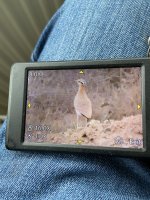8 January. Fuerteventura (Costa Calma)
Final day on Fuerteventura, decided to head south to the Costa Calma area. And a very good decision it turned out to be - finishing the trip on a high, Auduoin's Gulls, a vagrant Red-breasted Flycatcher, both Plain and Pallid Swift and the established Red-vented Bulbuls.
Getting there before tourists hit the beach, the first stop was the pretty amazing Playa de Sotavento - a shallow lagoon bordered by extensive beaches and offshore sand bars. Just about the only such habitat on Fuerteventura, it was not a surprise to find Sanderlings, Ringed Plovers and Kentish Plovers in abundance, probably approaching a mixed 250 of them in total. In lesser numbers, also Grey Plovers and Whimbrels, plus five Spoonbills, quite a few Grey Herons and Little Egrets and a couple of dozen Ruddy Shelducks. What was less expected was what was on the beach - in a mixed roost of Yellow-legged Gulls and Sandwich Terns, three very welcome Auduoin's Gulls too, two adults and one immature. Not hugely rare in the Canaries, but not a species I had been expecting. One Lesser Black-backed Gull and four Black-headed Gulls too.
Next stop was the small and rather scruffy park in Costa Calma. A narrow strip of forest sandwiched between roads, this site is nevertheless one of the easiest places in the Canaries to find wintering Common Chiffchaffs and the established population of Red-vented Bulbuls. And indeed, after fifteen minutes photographing a couple of Cattle Egrets on the centre of the nearby roundabout and admiring several low-flying Plain Swifts, I duly found both Chiffchaffs and Red-vented Bulbuls with ease, at least 25 of the latter feeding in exotic bushes at the bottom end of this park. Also flocks of Spanish Sparrows, a few European Robins, several Linnets, a couple of singing Blackcaps and one major surprise - rather active and mobile, preferring an area where the more luxuriant vegetation transitioned to pine, one very nice Red-breasted Flycatcher doing little sallies from low and mid-level branches! Absolutely had not expected this and, checking later, it appears this is only for the tenth record for the Canary Islands, a red letter bird indeed. Regrettably, it soon seemed to have vanished, possibly crossing the road into further green areas, but in an hour of searching, I did not see it again. A mix of butterflies here too - Monarchs and Small Whites most common.
Next stop was just ten minutes up the coast, the resort of La Lajita. Even without visiting the Oasis Wildlife Park with its giraffes et al, more exotica here - alongside native Great Grey Shrikes, Spanish Sparrows and a pair of Fuerteventura Stonechats, further Red-vented Bulbuls, plus both Hadeda Ibis and Sacred Ibis. With established breeding populations, both are looking set to follow the assorted parakeets and the bulbul that now call the Canaries home.
And so to the final port of call of the day, and indeed of the trip, I ventured inland a few kilometres to a series of small pools near La Calabaza. Almost dried out, these did not hold many birds beyond a few Black-winged Stilts and Little Ringed Plovers, but the skies above did throw a last little bonus - not only an Egyptian Vulture, but also a swirl of swifts. Assumed they would be Plain Swifts again, but no these were not - making repeated passes at the pools, no less than 15 birds in all, Pallid Swifts.
With that, a grand 44 bird species seen this day, we motored north, paused for sunset at Las Salinas, Sandwich Terns and Common Sandpiper the last birds of the day, then headed for the airport. Late evening flight to Madrid, trip over. In total, not bad for a hastily arranged Plan B trip, I had managed 104 species of birds (including exotics) and 21 species of butterflies.







